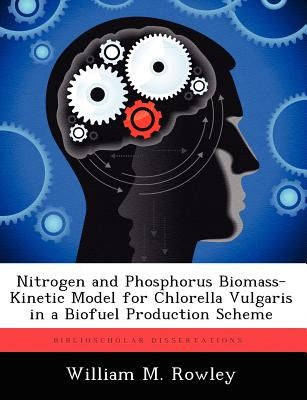
- We will send in 10–14 business days.
- Author: William M Rowley
- Publisher: BiblioScholar
- ISBN-10: 1249592925
- ISBN-13: 9781249592921
- Format: 18.9 x 24.6 x 0.6 cm, softcover
- Language: English
- SAVE -10% with code: EXTRA
Nitrogen and Phosphorus Biomass-Kinetic Model for Chlorella Vulgaris in a Biofuel Production Scheme (e-book) (used book) | bookbook.eu
Reviews
Description
Chlorella vulgaris was cultured in microbioreactors using Bold's Basal medium at varying nitrogen and phosphorus concentrations to define nitrogen and phosphorus utilization standards. Nutrient concentration was varied between 137 mg/L to 7.33 mg/L NO3-N and between 55.2 mg/L to11.0 mg/L PO₄-P in five test scenarios. All were grown under a constant photoperiod at 22±2°C and a mixture of 4 to 10% carbon dioxide/air. Maximum yield and growth rate occurred with the highest initial nitrogen and phosphorus concentrations. A statistically significant difference in biomass was found among all test levels at the end of the eight day growth period. Applying both Liebig's Law of the Minimum and the Blackman Limitation, it was determined that nitrogen was the limiting factor over the range of concentrations tested. Michaelis-Menten biokinetic coefficients (k), the reaction rate constant; the half saturation constant (Km); and Yx, the yield coefficients were also determined. To maximize C. vulgaris growth initial N concentration values should be 137 mg/L and should not be allowed to fall below 69 mg/L. No equivalent recommendation for P was determined. Yield coefficient calculations suggested that the N: P ratio should be at least 3:1. This study was conducted as a part of the ongoing advanced jet fuel project at the University of Dayton Research Institute and a part of the military objective to reduce the carbon footprint of jet fuel production.
EXTRA 10 % discount with code: EXTRA
The promotion ends in 20d.15:54:04
The discount code is valid when purchasing from 10 €. Discounts do not stack.
- Author: William M Rowley
- Publisher: BiblioScholar
- ISBN-10: 1249592925
- ISBN-13: 9781249592921
- Format: 18.9 x 24.6 x 0.6 cm, softcover
- Language: English English
Chlorella vulgaris was cultured in microbioreactors using Bold's Basal medium at varying nitrogen and phosphorus concentrations to define nitrogen and phosphorus utilization standards. Nutrient concentration was varied between 137 mg/L to 7.33 mg/L NO3-N and between 55.2 mg/L to11.0 mg/L PO₄-P in five test scenarios. All were grown under a constant photoperiod at 22±2°C and a mixture of 4 to 10% carbon dioxide/air. Maximum yield and growth rate occurred with the highest initial nitrogen and phosphorus concentrations. A statistically significant difference in biomass was found among all test levels at the end of the eight day growth period. Applying both Liebig's Law of the Minimum and the Blackman Limitation, it was determined that nitrogen was the limiting factor over the range of concentrations tested. Michaelis-Menten biokinetic coefficients (k), the reaction rate constant; the half saturation constant (Km); and Yx, the yield coefficients were also determined. To maximize C. vulgaris growth initial N concentration values should be 137 mg/L and should not be allowed to fall below 69 mg/L. No equivalent recommendation for P was determined. Yield coefficient calculations suggested that the N: P ratio should be at least 3:1. This study was conducted as a part of the ongoing advanced jet fuel project at the University of Dayton Research Institute and a part of the military objective to reduce the carbon footprint of jet fuel production.


Reviews